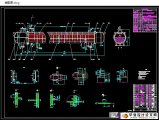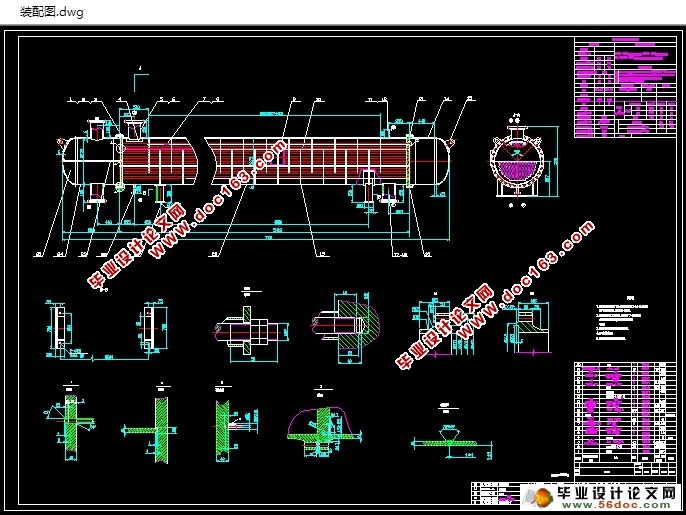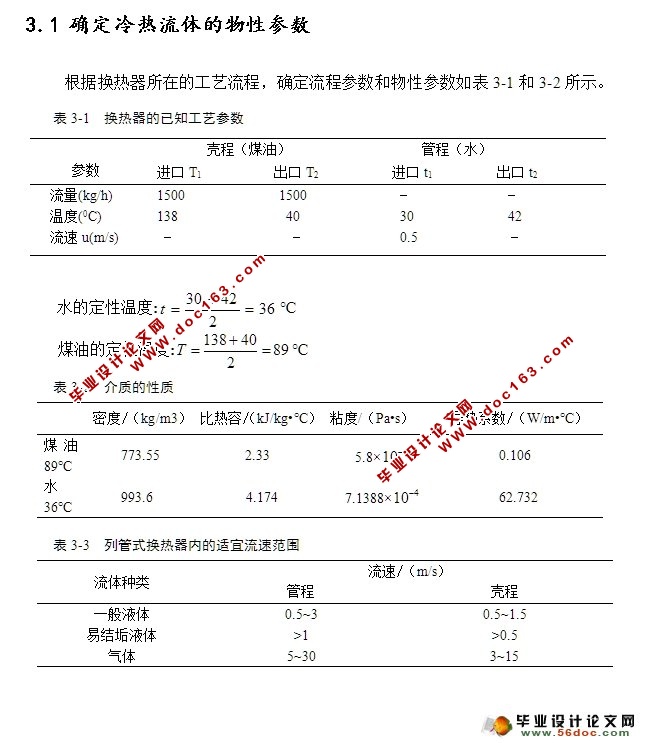煤油冷却器的设计(处理量1500kg/h)(含CAD零件装配图)

煤油冷却器的设计(处理量1500kg/h)(含CAD零件装配图)(设计说明书13300字,CAD图纸7张)
摘要
冷凝器是使用范围很广的一种化工设备,属于换热器的一种。本设计任务主要是根据已知条件选择采用固定管板式换热器的设计,固定管板式换热器的优点是锻件使用少,造价低;传热面积比浮头式换热器大20%到30%且旁路渗流小。
本台换热器主要完成的是煤油-水之间的热量交换,首先根据给出的设计温度和设计压力来确定设备的结构形式以及壳程和管程的材料,然后根据物料性质和传热面积来确定换热管的材料,尺寸,本次设计的主要设计参数为:管程介质为水,温度由30℃加热到42℃ ,工作压力 ,流量为 ,壳程介质为煤油,入口温度138℃,出口温度40℃、压力为 ,流量为 。采用Φ25×2.5的无缝钢管换热,并根据换热管的排列和长度来确定筒体直径以及折流板的选择。通过对容器的内径和内外压的计算来确定壳体和封头的厚度并进行强度校核。然后是对换热器各部件的零部件的强度设计,有法兰的选择和设计计算与校核,钩圈及浮头法兰的设计计算与校核和管子拉脱力的计算。还包括管板的结构设计、防冲挡板、滑道结构的设计以及支座设计。结构设计中的标准件可以参照国家标准根据设计条件直接选取;非标准件,设计完结构后必须进行相应的应力校核。 [资料来源:https://www.doc163.com]
管板与换热管的连接方式为焊接,因管板上的应力较多,且内外温度有一定的差值,因此,对管板强度的校核是一个重点,也是一个难点。
关键词: 冷凝器; 强度设计; 结构设计
Abstract
The condenser is the use of a wide range of a kind of chemical equipment, belongs to a kind of heat exchanges. This design task is mainly according to the known condition selection using fixed tube plate heat exchanges design, the advantage of fixed tube plate heat exchanges is forgings used less, low cost; Heat transfer area is from 20% to 30% larger than the floating head heat exchanges and the bypass seepage is small.
This primary finish is kerosene-water heat exchanges, the heat exchange between the first according to the given temperature and design pressure to determine the structure of device and the shell side and tube side of the material, then according to the material properties and the heat transfer area to determine the heat exchange tube material, size, the main design parameters of this design is: in the medium passes into water, heating temperature of 30℃ to 42℃, working pressure and flow for shell side medium for kerosene, inlet temperature of 1380 c, outlet temperature 40℃, pressure, flow rate is zero. Using Φ25*2.5 seamless steel tube heat exchanges, and according to the arrangement of heat exchange tube to determine cylinder diameter and length, and the choice of the baffle plate. through the container inner diameter and the internal and external pressure calculation to determine the thickness of the shell and head and intensity. and then to various components of the heat exchanges strength design of the parts and components have the choice of the flange and design calculation and checking, hook ring, and the calculation in the design of floating head flange and the checking and calculation of the force of tube pulled off. Includes the structure design of tube sheet, prevent the impact damper, the design of the track structure and support design. The structure design of standard parts can be reference to national standards according to the design conditions of direct selection; After non standard parts, design the structure must be corresponding stress checking. [资料来源:Doc163.com]
Tube plate and the heat exchange tube connections for welding, because of the stress of the tube plate more, and the internal and external temperature have certain difference, therefore, check is a key for the tubeless intensity, is also a difficulty.
Key words: Condenser; Strength design; The structure design



目 录
第一章 换热器的概述 1
1.1 课题研究的目的 1
1.2 课题研究的意义 1
1.3 本课题在国内外的研究现状 2
1.4 设计标准 3 [资料来源:https://www.doc163.com]
第二章 工艺条件的选择及设计方案 4
2.1 设计方案的拟定 4
2.2 温度 4
2.3 流动方式的选择 4
2.4 流速的选择 5
2.5 允许压降 5
2.6 材料的选择 5
第三章 换热器的工艺计算 6
3.1 确定冷热流体的物性参数 6
3.2 计算换热器的热负荷Q 6
3.3 冷却水的用量 7
3.4 平均温差的计算 7
3.5 选择传热系数初算传热面积 8
3.6 管子选择和管数的确定 9
3.6.1 管子的选择 9
3.6.2 管子的选择 9
3.7 平均温差的校正及壳程数 10
3.8 管子排列方式和管间距的确定 10
3.8.1 管子排列方式 10 [版权所有:http://DOC163.com]
3.8.2 管心距 11
3.9 壳程内径的确定 11
3.10 确定总传热系数 12
3.10.1 管程换热系数的确定 12
3.10.2 壳程侧换热系数的确定 12
3.11 流体压降的计算 14
3.11.1 管程压降的计算 14
3.11.2 壳程压降的计算 15
3.11.3 污垢热阻和管壁热阻 16
3.12 壳体壁温的计算 16
3.12.1 流体平均温度的确定 16
3.12.2 壳体壁温的确定 17
3.12.3 换热管壁温的确定 17
第四章 换热器的结构设计 19
4.1 管子与管板的连接 19
4.2 管板与壳体的连接 19
4.3 管板与分程隔板的连接 19
4.4 管板与法兰的连接 20
4.5 拉杆与管板的连接 21
4.6 折流板 21
4.7 流体进出口接管 24 [资料来源:https://www.doc163.com]
4.7.1 煤油进出口 24
4.7.2 水的进出口 24
第五章 换热器元件强度和刚度的计算 25
5.1 壳体设计及校核 25
5.1.1 设计参数的确定 25
5.1.2 强度计算 25
5.1.3 壳体的水压试验 26
5.2 封头 26
5.2.1 种类和参数的确定 26
5.2.2 强度计算 26
5.2.3 封头直边高度 27
5.3 管箱 28
5.3.1 强度计算 28
5.3.2 管箱的水压试验 28
5.4 管子与管板的拉脱应力 29
5.5 计算是否安装膨胀节 29
5.5.1 管、壳壁温差所产生的轴向力 29
5.5.2 压力作用于壳体上的轴向力 30
5.5.3 压力作用于管子上的轴向力 30
5.6 接管开口补强的计算 31
第六章 其他辅助结构及标准件的选用 34 [来源:http://www.doc163.com]
6.1 接管法兰及密封面形式 34
6.2 座的选择 34
6.2.1 换热器总质量的计算 34
6.2.2 鞍座的尺寸及结构选择 35
6.3 吊耳 36
6.4 法兰螺栓规格 36
6.5 拉杆与定距管 36
6.6 缓冲挡板 36
6.7 焊条的选择及焊接形式 37
6.8设计结果表 39
结论 40
参考文献 42
附录 44
致谢 46 [资料来源:http://doc163.com]
